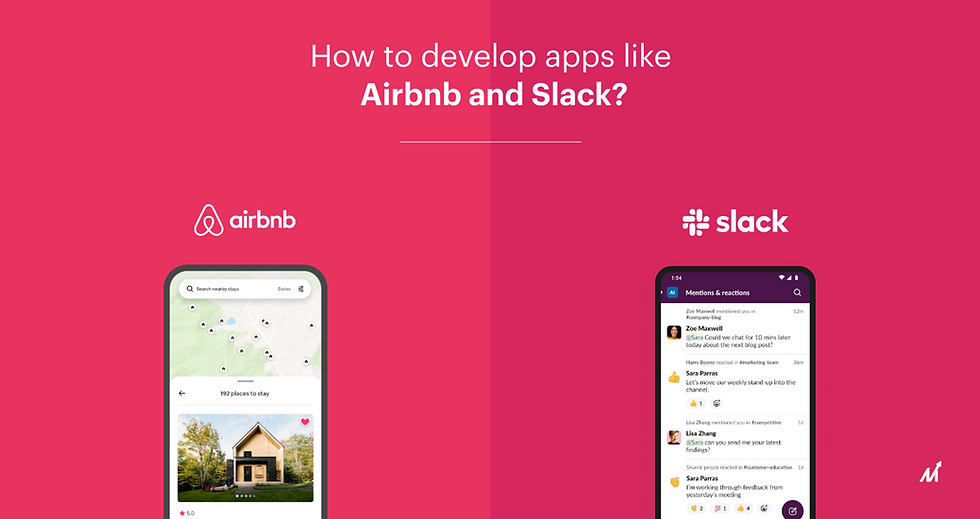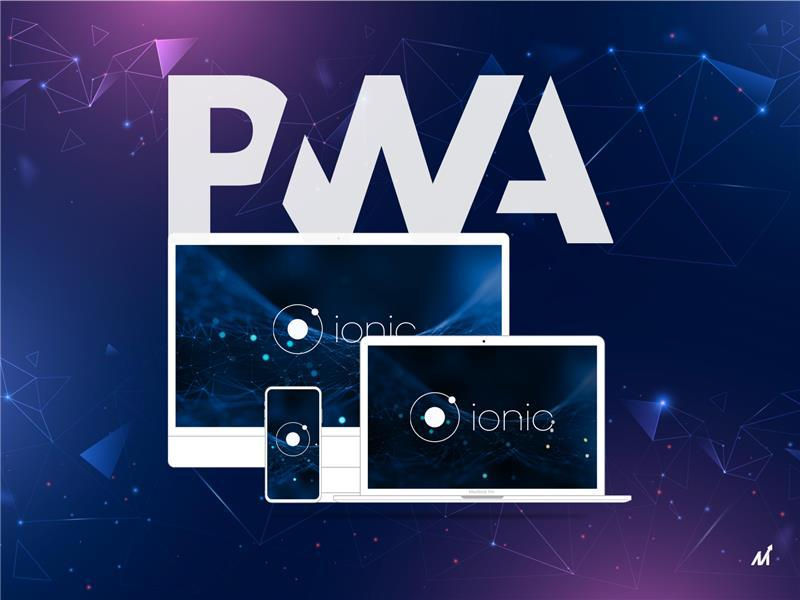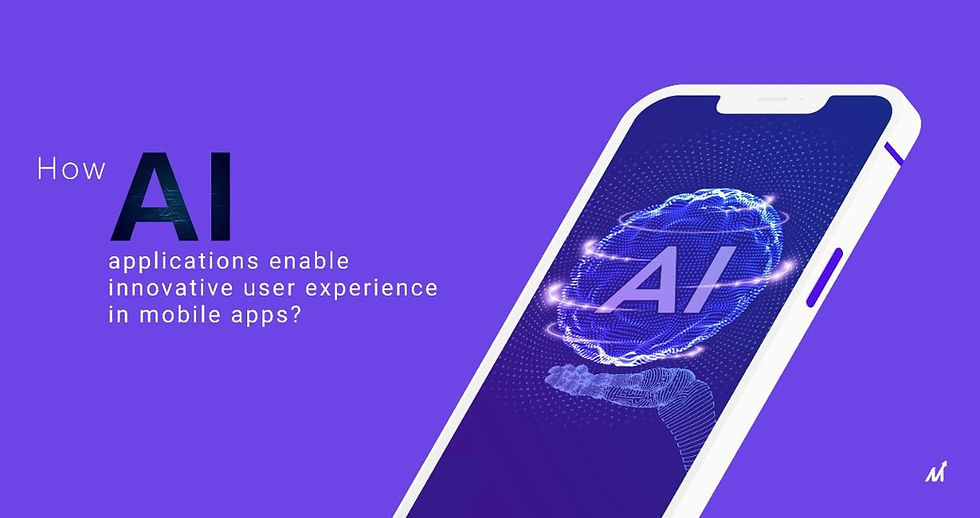How To Develop Apps Like Airbnb And Slack?
- amit9154
- Feb 25, 2022
- 6 min read

Mobile & web-based applications can be extremely beneficial in increasing business growth by opening new markets, expanding customer reach, increasing awareness of brands, enhancing the customer experience, and contributing to a variety of growth strategies. They also provide scope for efficiency that could drive economies of scale, leverage network effects and, which in turn, increase productivity and competitiveness. Digital technologies can substantially lower various costs like expenses for search, replication distribution costs, cost of tracking and verification.
Let's look at two such applications by big enterprises who have taken their respective sector with unprecedented speed and changed their businesses' growth and their customers reach to millions of people through their web and mobile applications.
Airbnb
Airbnb is an application used for online vacation rental that connects individuals looking for accommodation with people looking to rent their homes or their properties. Airbnb is accessible to people who own homes and travel to around 191 countries and 65,000 cities across the globe and has hundreds of listings to choose from. Due to its enormous growth, the business has been granted funding from more than 15 major companies, with raising $4.4 billion.
The Airbnb mobile and web app includes services such as a listing of user reviews and experience for diverse restaurants, accommodations costs for travellers and many more things in recent years. The first and most important thing to consider is that when developing an app similar to Airbnb, the app should provide a seamless transition from the starting to the final stage of using it. The app must be simple to use and provide a more user-friendly experience, which will result in positive reviews for the app.
The operation of Airbnb:
The property owner/property owner provides their home's details, including rules, amenities, prices and other details that draws the attention of travellers and tourists looking for accommodations.
Anyone looking for a rental property to rent will use the filter according to the cost range, the location and other criteria.
The next step is to request a book, in which travelers are required to submit a request to book a room at the hotel they prefer.
The owner of the property will take or decline the request according to the availability of the property.
When the property owner has accepted the reservation request, the deposit will be debited from the traveler's account. The remainder amount needs to be paid out after the time of stay by the tourist.
Finally, following the stay, both the homeowner of the Airbnb home and the traveller will be able to review their experience for future references for other homeowners and travelers.
Once you know what goes into making the Airbnb application functions Let's look at the programming languages and frameworks utilized to build the Airbnb application.
To develop an Airbnb duplicate app You will need to be aware of the entire tech stack according to the following:
Backend Frameworks like Node.js, Django or Ruby
Frontend Frameworks such as Vue.js, Angular.js, and React.js
Server-side technology like Azure, AWS, Google Cloud, and DigitalOcean
Technologies for managing databases such as MongoDB, MySQL, MSSQL, PostgreSQL, and Azure DocumentDB
Network Caching Services like Nginx and Redis
To create an app similar to like Airbnb This is the list of the options you can include for the best user experience:
Sign-up/Login In the beginning, users are required to sign-up for the website or application by providing basic personal details such as name, ID numbers or email address. If they are already registered they must sign in into the app by entering their login and password.
Search Filter: Filters enable users to specify their requirements such as property type size, dimension, price range as well as dates available so that they can find the property of their choice effortlessly.
Manage Account: This feature allows users to manage, update or modify their profile information and other details in the app, such as their password change etc.
Wish List: The wish list feature lets you save or mark any desired property by the user to be used in the future or in the event that it is not available.
Chat Notifications As a way of letting users know that a message essentially notifies the user, chat notifications inform users when they receive a message within their app chat.
Chatbot A user wants to interact with the property owner before booking, the chatbot feature helps.
Maps Maps locate properties on maps to ensure that the user can view the area overall and its surrounding locations.
Booking: This feature helps reveal the past of booking, and helps book the property of your choice.
Payments: This feature allows the guest to pay the duration of their stay to the property owner once they have completed the transaction. The feature also lets users look up their payment information the history of their transaction and to select the currency they want to pay in and also their payment method.
Help: The 'help' feature in an app allows to tackle any issue the users are facing and provides solutions via specially-curated FAQs or connecting them to support representatives and websites.
Review This feature lets users to share their experiences and opinions for travellers and homeowners.
Sharing When a user wishes to share the information about the property with another the property details can be shared easily it using the share feature. It lets them share the information on other social apps or on the app itself. Additionally, it offers the option of inviting other users to the app.
Airbnb offers more than seven million properties, and has users in over 200 nations. It is now so easy to property owners and travelers that it has more than 150 million customers. A higher number of people using the app means increased revenue and customers for your company.
Slack
Slack is one of the fastest-growing startups across the globe. It's a workplace/business communications tool. In just 8 months of it was launched, Slack reached a valuation of $1 billion. It was initially designed as a tool for game developers, Slack gained 8000 companies sign up within 24 hours of launching its famous remote working tool.
What was the process that helped Slack come up with such a useful remote working tool?
It's basically a basic messaging application. It's packed with interesting options like chat rooms that are public organized by the topic, direct messaging, as well as private groups. An administrator can accordingly define the user's accessibility to allow companies to easily control the data for different roles and hierarchies. Also, it is possible to create public channels like #random, which lets teams discuss informal or non-work discussions and foster relationships in the workplace.
Some of the functions of the Slack application are:
A Contact book
In-app search bar to find contacts, groups, media files and specific messages
Online/offline/typing status and visibility settings
Message exchange with reading receipt
Group messaging, delivered and read receipts
Video and Voice calls and group calls
Emojis that are custom-designed in the app
Media file transfer (pictures, videos, documents, contact cards, external links, etc.)
Customizable themes for user and wallpapers
Independent slack channels for different departments
Integrations from third-party providers like Google Drive and Office 365
Separating threads for seamless communication
Workflow Builder automates routine actions and communications
Event management tools like running sheets Gantt chart, calendars that are specific to events
Slack is accessible as a web-based app, desktop application, and mobile app. It can be accessed on every mobile device, any browser, and standalone desktop application.
Web
Slack's core is an amalgamation of JavaScript/ES6 and React.js to run on the Web platform. When Slack launched the Windows application, they could not use the previous codebase. In order to make it available on every type of devices and the web, Slack decided to implement cross-platform development tools like Electron.
Desktop
Slack's desktop application is also developed using Electron to provide a frameless, quicker look and feel of the application as well as a myriad of features to improve the user experience. The Electron framework has enabled desktop applications for cross-platforms using programming languages like JavaScript, HTML and CSS.
But, the original desktop app was built using the MacGap v1 framework. It relied on WebView to host web content within the native app framework. However, it was not easy to upgrade it with the new features that are only available to Apple's WKWebView and switching to this view required an entire change to the application.
Although there is a possibility that Slack desktop is a hybrid system but the codes and assets loading were distributed for the most part. The Slack developers integrated Chromium as well as Node.js to create a rendering engine as well as a module system. The new desktop app is now built upon the ES6 and async/await React application, which slowly changes to TypeScript.
Mobile
Slack is built using the combination of languages for programming, Java along with Kotlin on Android.
For iOS the application is written in a combination with Objective-C in addition to Swift.
In order to create an app that is successful it is essential to take a strategic approach during the process of development is important. Along with full development of the product, deploying technologies to sustain the product development, features enhancement and other areas of development. A Minimum viable product or MVP helps in developing a user-friendly product and software design that can easily be checked before unveiling the final product. A lot of enterprises create MVP first and launch with a small group of users to test the features and functions. They gather feedback from their users and incorporate the feedback into their final product. MVP is also a great option to start a campaign to raise funds in order to launch the app. It can also be used to verify the app's concept. First published here







Comments